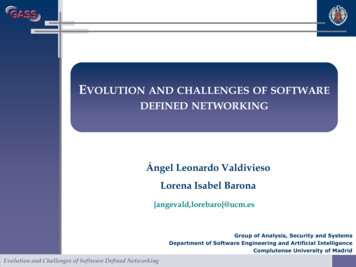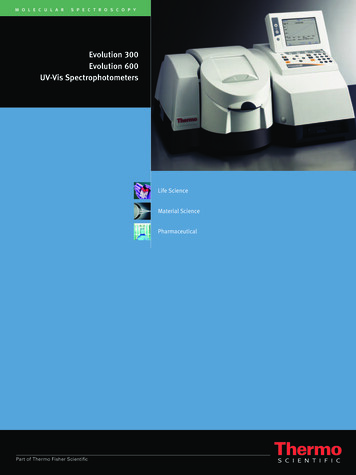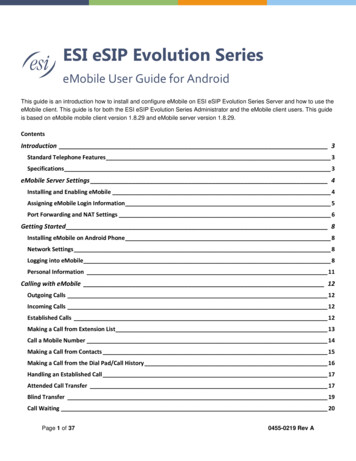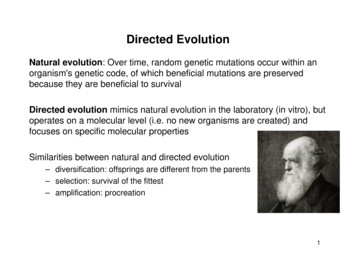
Transcription
Challenges of Evolution towards818 SP中关于网络架构的一Autonomous Network些思考Chang YueChief Architect of Network Product Line
The motivation of autonomous network58%Pulled by customer requests75BConnecteddevicesby 2025OPEX RevenueExperienceissues driven bycomplaintsNetwork complexitiesbeyond humancapabilitiesLast decadeSystemarchitectureinnovationto solve structuralproblemsPushed by structural problems3 OTT players 300 TelcosvsEfficiency to maintain 10,000 devices
Key gaps and differences between OTT and CT 3000 devices / person in Hyper-scale DC 4 hours OTT New Service ProvisioningCAPEX 10% Traffic Double Growth 100 Devices / person in Telco-S network 28 weeks Private Line Service ProvisioningCAPEX 60% Traffic Double GrowthCloud Data Center NetworkTelco NetworkCloud Service LayerCloud ServiceSystem, OPS etc.Network Operation LayerCustomer Service LayerResidentialService ITsystemSDN ControllerOverlay Network : Logic Network Service (vsw/DVR/vFW )Underlay Network SpineLeafLeafBusinessService ITsystemSpineLeafNetwork Operation LayerNetwork LayerSpineLeafVSCPELeaf Decoupling of network transport & service in hardware and softwareindividuallyAccessCore PE/BNG& Metro PE/BNGNetworkNetworkNetwork ServiceBRASVPNVxLANSRNetwork ServiceTransport Service Coupling network transport & service into dedicated HW, difficult to scale upindependently Spine/Leaf Arch, elastic scale out, any to any non-blocking Aggregation network with bandwidth convergence Simplified protocols, reduce O&M experience requirements 30 protocols, high experience requirement Clear boundary of Network operation and Service system, Automatic service Unclear boundary of network operation and service IT system, Low efficiency by
Vision and goal of the autonomous networkBest NetworkValue Revenue sionEnablerHigher Operation EfficiencyBetter Customer Experience Always on by resilience Guaranteed SLA with closed-loop SecurityTCOOpen & Programmable Minimal manual work with ZTOs and NO NOC Fast TTM with No change management No legacy lock-in with easy migration Adjacent and new business opportunities Open ecosystem for vertical business Open for business intelligenceZero Touch OperationEase NOC(Proactive process by software to ease NOC)Continuous service Provisioning(No service impact and exception handling)Mitigate migration Pain(Process Clean up)Always on and on demand Network InfrastructureScale out architecture(Service agnostic Transport)Zero-touchAutomationClosed-loopStability and Resilience(Robustness design)VirtualizationSoftware upgrade for network service(NW Phase out, Virtual service)Real-time performance & SLA(Advanced Telemetry)Big dataanalyticDigital Twin(Model-based)AIRPADevOps
Autonomous Network Reference ArchitectureFull lifecycle OperationsCustomer intentDesignCustomerIntentDesignCustomer service IT ACS (Autonomous Control System)ClosedLoopCustomer ACustomer BCustomer CPlanOptimizationDesignAssuranceService intent with SLARolloutProvisionNetwork Service ACS (Autonomous Control System)ServiceIntentDesignResidentialService 1AClosedLoopEnterpriseService 2BMobileService 3CIntent ngineNetwork intent with SLANetworkIntentDesignNetwork Transportation ACS (Autonomous Control portation (Underlay) and Service (overlay) NetworkCloud/Edge Computing InfrastructureNSECPEAccess &MetroNetworkNSECoreNetworkAccess &MetroNetworkConnection3-D3Decoupling ofTransport andServiceCPEAutonomous Control System- AI-powered, data-driven closed-loop architecture- Model-driven control & automationNetConf/YANGReal-time TelemetryUnderlay/Overlay Network
Principles for decoupling of network service andtransportationTransportation (Underlay) and Service (overlay) NetworkCloud/Edge Computing InfrastructureNSECPEAccess &MetroNetworkNSECoreNetworkAccess &MetroNetworkCPENetwork service and transportation technology are agnostic mutually and can be replacedindependently;Various transportation with different technology can be chosen for specific serviceMultiple kinds of service can be supported by a specific transportation technology
Key design challenges for network transport layer① Decoupled from serviceP2P ServiceP2MP ServiceMP2MP Service② Simplified protocols system to make it easy forLow LatencySLA DifferentiationNetwork SlicingO&M, and more robust networkQoS VisualizationAutomation③High utilization by routing with service SLA as inputMulticast ServiceOn-Demand Bandwidth ④High Availability, to recover underlay path quickly atUnderlayfailure, without awareness by overlay, lower theprotection requirement of overlay⑤Automatic O&M, based on machine analysis ansinference, lower the bar for O&M personnelrequirement⑥Open programmability, provide P2P & P2MPUnified Transportservice to overlay, with open SLA capability etcHow to guarantee the capacity growth andresource utilization with reasonable cost?How to visibility and guaranteeSLA of service?How to achieve always-onunderlay?
Simplify the network transportation protocol with SRLegacy Protocols NRSVP-TEVXLANVLANVXLANSimplified Protocols SystemEVPNAccessUnified TransportationEVPNIP BackboneDCIP Metro10 Protocols - 2 e SR/EVPNSeamless1 hopservice automation optimization of pathfrom access to applicationMulti-domain - SeamlessACCESS-METRO-CORE-DC ACCESS-DCSimplifiednative IP forwarding pathcontrolAll Scenariosbackhaul , leased private line,home access, cloud
Use case of Cloud based overlay virtualized network1. Deploy VNFs for overlay network, including XGW, VGW, etc. Separate services and transportation network2. XGW connects tenant VPCs cross-region through VXLAN tunnel on overlay layer, DCI Physical backbone network onlyprovide IP connectivity and do not concern the tenant information.3. VGW work as the unified VPN Access point of massive tenant sites via lease Line/MPL S VPN and IPSEC VPN etc.4. VGW connect to XGW, vRouter through VXLAN. The DCN only provide IP connectivity and do not concern the tenantinformation.5. XGW, VGW and other VNF support scale-outHuawei practice on public cloud,overlay with millions of WRDCI/BackboneRVPN/Lease-LineKey Targets:- One point access for global network- Service provisioning in minutes and routing convergence in secondsSWDCNSWCPERAccessVPN/Lease-LineR
Use case of SD-WAN, overlay service network for enterpriseChallenges for SD-WAN: Very big scale: massive tenants and CPE Smart routing: based on service level, policy, by tunnels Complex security environment: efficient security mechanism required Efficient protocols; light-weight , to support routing, path steering, policy and security Complex network environment: multiple IP address and dynamic IP address with CPE, NAT traversal, multi-layer NAT SD-WANControllerBranchCPESD-WANControllerCloudvCPE VPCTenant service networkBranchCO/Edge DCCPEvFWTenant service networkBranchCPECPEBranchRLease Line/MPLS VPNInternetvCPE VPCVGWCPERRvFWCPERRCO/Edge DCVGWHeadquarterCloudCO/Edge arterRAll SD-WAN vendors/providers are develop their proprietary protocols or extension to meet requirements, such as BGPextension to distribute tunnel and policy and to implement secret key negotiation. The explosion of SD-WAN solutions makesthe interoperation very hard. Meanwhile, the security of each solution is not guaranteed.Suggest IETF to standardize technology for SD-WAN, including protocols and security;
Open network capability based on YANG model to enableautomation Network automation is a network-wide mechanism, which involves various network element, software component, platform from variousvendors. Capability openness is key for network automation. Traditional management protocols, such as CLI, is not optimized for software processing and difficult for operating programmatically.Transaction-based tools, optimal to software, good at validating results, are needed to fill the gap. YANG data Model driven management is the most practical and widely adopted approach. Decouple Service Model from ResourceModel provide agile service creation, delivery and maintenanceNetwork Service YANG Model-Independent of technology and operator, vendorSpecify by operator on service intent(i.e.,whatcustomer wants), but not how to implement it, usingbusiness-friendly conceptModel Driven Service API, e.g., IETF L3SM modelNetwork YANG Model-Specify how to realize the serviceVendor Neutral vs Vendor specificProvide Network visibility and support troubleshooting and diagnosticExpose resource to customerAllocate resource and tune resource distribution.Customer intentDesignCustomerIntentDesignCustomer service IT ACS (Autonomous Control System)ClosedLoopCustomer ACustomer BCustomer CService intent with SLANetwork Service ACS (Autonomous Control vice 1AEnterpriseService 2BMobileService 3CNetwork intent with SLANetworkIntentDesignNetwork Transportation ACS (Autonomous Control ction3-D3
Expediting the standard process of YANG modelIETF has already developed plenty of YANG model standards, thank you!ServiceModels I2NSFI2RS TopologyL3SM/L2SMACTNProtocolsModels Interface BGPOSPFSegment RoutingThe industry wants the YANG models now, while many IETF YANG model work are still in WG drafts or even individual drafts phase.Suggest to expedite the process. A simplified standard model is still better than none.There are many YANG model standardization work across various standards organizations. Overlapping may happen, suggest IETFto participate more industry coordination, even lead the effort.The industry does not know IETF model well! Suggest IETF to advertise its YANG model, especially service YANG model, to theindustry.
Challenge for analytics and intelligence of autonomousnetworkRoot Cause Classfication of Service Fault inDCIssues of service&experience perspectiveConfiguration Error ofNetwork(43%)Bug of HW/SW(20%)Abnormal of ITInfrastructure(30%)Resource Exhaustion(7%)Connectivity(70%):Interrupt of servicePerformance(20%):Bad experience ofservicePolicy(10%):Abnormal serviceaccess Lack of data for fault cause analysis Not coverage completely from chipset, device, network, ITinfrastructure, flow and applications Low sampling frequency, min - ms; Lack of historic data, 90% does not support fault playbackAbnormal70%Unaware Unaware of abnormal application and network status, majority faults areTraffic:viadetected passively3.65%traditionalapproaches Lack of capability to correlate the issues between network andapplications Capability to predictive resource exhaustion( 7%), bugs of HW/SW( 20%),configuration error( 43%) Data from some real typical medium DC(5300 VM, 65 subnet)30%Aware viatraditionalapproaches Average number of flow:96,545,774/day,among them 3,543,230(3.67%) are abnormal
How to improve the analysisin capability of autonomousnetworkImagine You Can Know Everythingabout Your network and service BehaviorData AnalyzerTransportation State DatabaseNetwork real-time status andbehavior modelService State DatabaseApp flow, real-time status, andbehavior modelContext DataChipset, Device, Path, and FlowPolling-based, focus ondevice statusStatic topology-based,focus on device linksTraditionalAfterward event-drivenApp-oriented black boxnetwork, focus onmanagement planeTelemetry-based, focus on realtime fabric statusDynamic path-based,focus on app flowsTransparent network, focus onactual forwarding planeData AnalyzerReal-time data-driven
Technology full stack of network analysis & IntelligenceTrainingAI Training Cloud (offline typically)datamodelAnalysis(online typically)AnalysisOLAPinferenceDataLakeThe interface among Training, Analysis andCollection components are service interfaces.Service models can be standardized but in manycase not required because it’s internal tosoftware system.dataCollectorCollectionconfigurationTo define what the network element shouldsubmit, in what format, encoding, protocols,the domain of standardization, especially thecapability of network elements.dataManagement/Control PlaneCPU, memory, log, alarm, statistics, topology,NetworkProtocol PDU, RIB, route policy ElementswithReal-time Data PlaneFlow data: latency, jitter, packet loss, queuetelemetrydepth gRPC, etc UDP/iOAM/IPFIX, etc Data Subscription: YANG pushData Process: Smart filter, soft/hard DNP (dynamicnetwork probe), Sketch, Marking TriggerData Export: BMP, iOAM, IPFIX, UDP, Netconf, gRPC
Case Study: Route loop detection, localization, root causeanalysis and prediction Troubleshooting use cases Routing table error, e.g., route loop Route loop types1. Loop currently exists, and reflected at thedata plane2. Loop currently exists, but not yet reflectedat the data plane (i.e., no data flow iscurrently traversing the path)3. Loop currently does not exist, withenvironment change (e.g., link failure), theloop appears Gap and Motivation Traditional device-by-device CLI check is bothtime and labor consuming Having difficulty correlating the route loop withroot cause Not capable of predicting route loop Objective Detecting and locating issues in seconds/minutes Accurate root cause analysis to module/configuration /policy Control plane simulation for loop predictionLoopdetection/localizationData collectionData rocess /exportProtocol PDU;TTLProtocolalarmsneighbor states;Correlated routeData planepolicy & routeanomaly/alarmschange eventrecord;Correlated route policyand route change eventrecord and analysisRoot cause analysisLoopdetectionalgorithmNetwork-wideRIB collectionand analysisData analysisControl planesimulation for looppredictionControl plane snapshot;Control plane simulationwith environment factorchange, e.g., link failure
Security ConsiderationMetroBackboneDCSDWAN5GIoTAutonomous NetworksRoutingDDoSTransport ProtocolLayer 2 SecurityPhysical Security IssuesIETF security protocols: E2E encryption: TLS, IPSec AAA: EAP, AUTH: Kerberos, Radius, Diameter Routing: RPKI, IPv6Sec, PKIX DNS: DNSSEC, DANE Internet: httpauth, Oauth, Tokbind Codec: CMS,JOSE IoT: ace, core, suit, t2trg Question: Different network scenarios face different security issues, how to design a reasonable security for each ofthem.Suggestion : IETF works more closely with other SDOs ( IEEE-802.11/802.15, BBF, 3GPP, etc. ) to design the suitable securitysolutions, prevent network security from impeding the interworking of global network.
Maturity level suggestion of autonomous networkA: AutomatePA:Partially AutomateServiceL5: nAwarenessAAPAPAAPAL3: ConditionalAutonomousNetworkL2: PartialAutonomousNetworkL1:Assisted O&ML0:Manual OAML4:HighlyAutonomousNetwork Closed-loop automationcapabilities across multipleservices, multiple domains,and the entire lifecycle.In a multi-domain environment,predictive or proactive closed-loopmanagement of service andnetworks.Senses environmental changes in real time,optimize and adjust itself to the externalenvironment for closed-loop management.Closed-loop O&M for some component underspecific external environments, lowering the bar forpersonnel experience and skills.Executes certain sub-tasks based on existing rules toincrease execution efficiency.Assisted monitoring capabilities, which means all dynamic tasks haveto be executed manually.
SummaryKey for autonomous network:Decoupling network transportation and service, transportation prefer to HW and service prefer toSW- Simplify the protocol for network transportation, realize e2e seamless network- Enhanced the protocol for network service, esp. for scalability, flexibility and securityDecoupling network operation and service IT system based on model-driven automation engine- Standard for network and service YANG model are very importantClose-loop control is the key for autonomous and AI is essential for proactive maintenance- Telemetry definition is very important for network analysis and intelligence- Domain knowledge is critical for data analysis efficiencyAutonomous network is a long journey and need collaboration of industry
Thanks!Copyright 2018 Huawei Technologies Co., Ltd. All Rights Reserved.The information in this document may contain predictive statements including, without limitation, statements regarding the future financial andoperating results, future product portfolio, new technology, etc. There are a number of factors that could cause actual results and developments todiffer materially from those expressed or implied in the predictive statements. Therefore, such information is provided for reference purpose only andconstitutes neither an offer nor an acceptance. Huawei may change the information at any time without notice.
The explosion of SD-WAN solutions makes the interoperation very hard. Meanwhile, the security of each solution is not guaranteed. Suggest IETF to standardize technology for SD-WAN, including protocols and security; R R Lease Line/MPLS VPN R CPE Branch CPE CPE Headquarter vCPE VPC Cloud Tenant service network SD-WAN Controller VGW Branch CPE CO .










